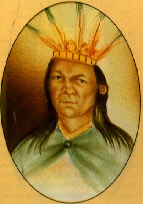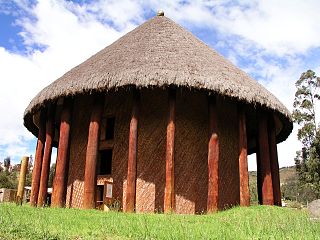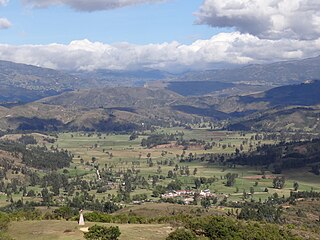
The Muisca are an indigenous people and culture of the Altiplano Cundiboyacense, Colombia, that formed the Muisca Confederation before the Spanish conquest. The people spoke Muysccubun, a language of the Chibchan language family, also called Muysca and Mosca. They were encountered by conquistadors ordered by the Spanish Empire in 1537 at the time of the conquest. Subgroupings of the Muisca were mostly identified by their allegiances to three great rulers: the hoa, centered in Hunza, ruling a territory roughly covering modern southern and northeastern Boyacá and southern Santander; the psihipqua, centered in Muyquytá and encompassing most of modern Cundinamarca, the western Llanos; and the iraca, religious ruler of Suamox and modern northeastern Boyacá and southwestern Santander.

Tunja is a city on the Eastern Ranges of the Colombian Andes, in the region known as the Altiplano Cundiboyacense, 130 km northeast of Bogotá. In 2018 it had a population of 172,548 inhabitants. It is the capital of Boyacá department and the Central Boyacá Province. Tunja is an important educational centre of well-known universities. In the time before the Spanish conquest of the Muisca, there was an indigenous settlement, called Hunza, seat of the hoa Eucaneme, conquered by the Spanish conquistadors on August 20, 1537. The Spanish city was founded by captain Gonzalo Suárez Rendón on August 6, 1539, exactly one year after the capital Santafé de Bogotá. The city hosts the most remaining Muisca architecture: Hunzahúa Well, Goranchacha Temple and Cojines del Zaque.

Duitama is a city and municipality in the department of Boyacá. It is the capital of the Tundama Province. Duitama is located 240 kilometres (150 mi) northeast of Bogotá, the capital city of Colombia and 50 kilometres (31 mi) northeast of Tunja, the capital Boyacá. Duitama has existed since pre-Columbian times, when the Muisca inhabited the hills surrounding a former lake in the valley. The original name of Duitama was "Tundama", named after cacique Tundama. The elevation of the city is about 2,590 metres (8,500 ft) above sea level and the average temperature is 16 °C. Duitama is known as "The Pearl of Boyacá".

The Altiplano Cundiboyacense[altiˈplano kundiβoʝaˈsense] is a high plateau located in the Eastern Cordillera of the Colombian Andes covering parts of the departments of Cundinamarca and Boyacá. The altiplano corresponds to the ancient territory of the Muisca. The Altiplano Cundiboyacense comprises three distinctive flat regions; the Bogotá savanna, the valleys of Ubaté and Chiquinquirá, and the valleys of Duitama and Sogamoso. The average altitude of the altiplano is about 2,600 metres (8,500 ft) above sea level but ranges from roughly 2,500 metres (8,200 ft) to 4,000 metres (13,000 ft).

Gámeza is a town and municipality in the Colombian Department of Boyacá, part of the Sugamuxi Province, a subregion of Boyacá. The town center is located at 18 kilometres (11 mi) from Sogamoso and the municipality borders Tasco and Corrales in the north, Tópaga and Mongua in the south, in the east Socotá and westward of Gámeza Corrales and Tópaga.

Bacatá is the name given to the main settlement of the Muisca Confederation on the Bogotá savanna. It mostly refers to an area, rather than an individual village, although the name is also found in texts referring to the modern settlement of Funza, in the centre of the savanna. Bacatá, alternatively written as Muequetá or Muyquytá, was the main seat of the zipa, the ruler of the Bogotá savanna and adjacent areas. The name of the Colombian capital, Bogotá, is derived from Bacatá, but founded as Santafe de Bogotá in the western foothills of the Eastern Hills in a different location than the original settlement Bacatá, west of the Bogotá River, eventually named after Bacatá as well.

Tisquesusa, also spelled Thisquesuza, Thysquesuca or Thisquesusha was the fourth and last independent ruler (psihipqua) of Muyquytá, main settlement of the southern Muisca between 1514 and his death in 1537. The Spanish pronunciation of his name brought about the Colombian capital Bogotá. Tisquesusa was the ruler of the southern Muisca Confederation at the time of the Spanish conquest of the Muisca, when the troops led by Gonzalo Jiménez de Quesada and his brother entered the central Andean highlands.

Quemuenchatocha or Quimuinchateca was the second-last hoa of Hunza, currently known as Tunja, as of 1490. He was the ruler of the northern Muisca when the Spanish conquistadores arrived in the Muisca highlands. His contemporary enemy psihipquas of the southern Muisca were successively Nemequene and Bogotá.

Michuá or Michica was the second zaque of Hunza, currently known as Tunja, as of 1470. His contemporary enemy zipa of the southern Muisca was Saguamanchica.

Nemequene or Nemeguene was the third ruler (zipa) of Bacatá as of 1490. His zaque counterpart ruling over the northern area of the Muisca territory was Quemuenchatocha.

The Battle of Chocontá was one of a series of battles in the ongoing conflict between the northern and southern Muisca of pre-Columbian central Colombia. The battle was fought c. 1490 in the vicinity of Chocontá. An army of 50,000 southern Muisca guecha warriors, led by their ruler, or zipa, Saguamanchica, attacked 60,000 northern Muisca troops commanded by Zaque Michuá, who was supported by the Cacique of Guatavita.

The Muisca Confederation was a loose confederation of different Muisca rulers in the central Andean highlands of present-day Colombia before the Spanish conquest of northern South America. The area, presently called Altiplano Cundiboyacense, comprised the current departments of Boyacá, Cundinamarca and minor parts of Santander.

Idacansás, Idacansas, Idacanzas or Iduakanzas was a mythical cacique who was said to have been the first priest of the sacred city of Sugamuxi, present-day Sogamoso, Colombia, then part of the territories of the Muisca. He is characterized by his great magical powers as he could make rain and hail and transmit diseases and warmth.

Pacanchique was a person in the mythology of the Muisca. He is said to have been the son of the cacique of Ramiriquí; Baganique. During that time, Ramiriquí was part of the zacazgo of Quemuenchatocha of the northern Muisca Confederation. Pacanchique's fiancé, Azay, is said to have been kidnapped by Quemuenchatocha and Pacanchique did all to get her back, eventually leading the Spanish conquistadores to Hunza to beat Quemuenchatocha.

The iraca, sometimes spelled iraka, was the ruler and high priest of Sugamuxi in the confederation of the Muisca who inhabited the Altiplano Cundiboyacense; the central highlands of the Colombian Andes. Iraca can also refer to the Iraka Valley over which they ruled. Important scholars who wrote about the iraca were Lucas Fernández de Piedrahita, Alexander von Humboldt and Ezequiel Uricoechea.

Tundama or Saymoso was a cacique of the Muisca Confederation, a loose confederation of different rulers of the Muisca who inhabited the central highlands of the Colombian Andes. The city of Tundama, currently known as Duitama and part of the Tundama Province, Boyacá, were named after the cacique. Tundama ruled over the northernmost territories of the Muisca, submitted last by the Spanish conquistadores.

Sugamuxi was the last iraca; cacique of the sacred City of the Sun Suamox. Sugamuxi, presently called Sogamoso, was an important city in the religion of the Muisca who inhabited the Altiplano Cundiboyacense in the times before the Spanish conquistadors reached the central highlands of the Colombian Andes. Fellow Muisca rulers of other territories within the Muisca Confederation were Tundama in Tundama, zaque Aquiminzaque in Hunza and zipa Sagipa in Bacatá.

The Hunzahúa Well is an archeological site of the Muisca located in the city of Tunja, Boyacá, which in the time of the Muisca Confederation was called Hunza. The well is named after the first zaque of Hunza; Hunzahúa. The Well was called Pozo de Donato for a while, after 17th century Jerónimo Donato de Rojas. The well is located on the terrain of the Pedagogical and Technological University of Colombia in Tunja. Scholar Javier Ocampo López has written about the Well and its mythology. Knowledge about the well has been provided by scholar Pedro Simón.

The Spanish conquest of the Muisca took place from 1537 to 1540. The Muisca were the inhabitants of the central Andean highlands of Colombia before the arrival of the Spanish conquistadors. They were organised in a loose confederation of different rulers; the psihipqua of Muyquytá, with his headquarters in Funza, the hoa of Hunza, the iraca of the sacred City of the Sun Sugamuxi, the Tundama of Tundama, and several other independent caciques. The most important rulers at the time of the conquest were psihipqua Tisquesusa, hoa Eucaneme, iraca Sugamuxi and Tundama in the northernmost portion of their territories. The Muisca were organised in small communities of circular enclosures, with a central square where the bohío of the cacique was located. They were called "Salt People" because of their extraction of salt in various locations throughout their territories, mainly in Zipaquirá, Nemocón, and Tausa. For the main part self-sufficient in their well-organised economy, the Muisca traded with the European conquistadors valuable products as gold, tumbaga, and emeralds with their neighbouring indigenous groups. In the Tenza Valley, to the east of the Altiplano Cundiboyacense where the majority of the Muisca lived, they extracted emeralds in Chivor and Somondoco. The economy of the Muisca was rooted in their agriculture with main products maize, yuca, potatoes, and various other cultivations elaborated on elevated fields. Agriculture had started around 3000 BCE on the Altiplano, following the preceramic Herrera Period and a long epoch of hunter-gatherers since the late Pleistocene. The earliest archaeological evidence of inhabitation in Colombia, and one of the oldest in South America, has been found in El Abra, dating to around 12,500 years BP.

This article describes the warfare of the Muisca. The Muisca inhabited the Tenza and Ubaque valleys and the Altiplano Cundiboyacense, the high plateau of the Colombian Eastern Ranges of the Andes in the time before the Spanish conquest. Their society was mainly egalitarian with little difference between the elite class (caciques) and the general people. The Muisca economy was based on agriculture and trading raw materials like cotton, coca, feathers, sea snails and gold with their neighbours. Called "Salt People", they extracted salt from brines in Zipaquirá, Nemocón and Tausa to use for their cuisine and as trading material.































